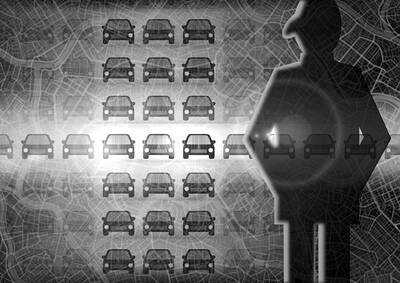The earth began to move 40km below the seabed, a massive rupturing of the earth's crust off the northwestern tip of Sumatra.
A section of seabed 1,000km long rose up to 30m at a spot approximately 250km southeast of the city of Banda Aceh and 1600km northwest of the Indonesian capital of Jakarta.
Millions of people were living, fishing and holidaying around the Bay of Bengal and on the coast of Thailand and Malaysia, hundreds of kilometers from the epicenter. They were not to know that the gentle shaking that caused sky-scrapers in Singapore and Chiang Mai in northern Thailand to sway would unleash a devastating tsunami, bringing a wall of water crashing down on their shores.
Mohammed Firdus, 36, a telephone operator from Bireuen, Aceh province, was sitting on the porch of his house, about 200m from the sea, when the earthquake struck.
Then he heard a rumbling, but this time the ground was not shaking. Someone came running fast from the beach, shouting, "huge wave, huge wave."
Firdus said: "And then I saw the water. It was a wall at least a meter high coming down the track towards us all. We all immediately turned and ran towards the main road with the water following us."
Officials said it was impossible to say how many people were killed by the earthquake itself because it was followed so quickly by tsunamis striking Aceh province and smaller islands like the popular surfing resort of Nias, where an entire hotel, the Wismata Indah, was washed out to sea.
"The wall of water which came ashore was between 5m and 10m high in many places," said Ari Meridal, a provincial government official in Banda Aceh. "It swept almost everything away for hundreds of meters inland."
Severed communications meant that estimates of casualty figures were imprecise.
"We have heard very little from west Aceh, which is the nearest point to the epicenter," said Raifa Sistani, of the Indonesian Red Cross. "This is a major concern to us because logic says this area should have suffered the most."
Thailand
The packed Thai tourist resorts on Phuket and Phi Phi islands were the next to be hit with a succession of tsunamis 10m high.
Montri Charnvichai, a resident of Phuket, was on the beach at 10am when the sea water suddenly disappeared and the beach dried.
He said: "Then the first wave hit. It must have been traveling at about 70km per hour, it was very fast. It swept up the beach, carrying everything with it. There were many, many people in the sea at this time, and many of them were tourists. I have no idea what happened to them."
Then the second wave hit, about two minutes after the first. It was 3m high, and crashed into the buildings lining the shore.
Simon Clark, a British photographer holidaying on Koh Ngai, described a huge wave crashing on to the beach, destroying everything in its wake.
"People who were snorkeling were dragged along the coral and washed up on the beach, and people who were sunbathing got washed into the sea," he said.
The tsunami struck Phuket just after 10am, when Christmas revelers were just starting to surface.
"It was like a really, really bad dream," said Dawn Taylor from Stockport, England, who was on Kamala beach. "It was a glorious day and a group of us were enjoying the beach when suddenly we saw this wall of water coming towards us. We just ran. The scale of the devastation is just enormous."
About 70 divers, many of them foreign tourists, who were exploring the famed Emerald Cave were plucked to safety after the first couple of waves struck.
The more remote Phi Phi islands, where the Leonardo DiCaprio film The Beach was filmed, were hit even more
badly than Phuket. Heavy seas, however, prevented people from being evacuated.
Malaysia
Most of the fatalities in Malaysia were people swimming and jet skiing off beaches on the island of Penang who were struck by the tsunami. Other deaths were reported on the mainland, in Perak and Kedah states, from both tsunamis and the original quake as thousands of buildings were damaged or destroyed.
"It was crazy," said Lin Wei Song, a restaurant owner on Batu Ferringhi. "One minute I was preparing for the lunchtime rush and then the next thing I knew was that my tables were floating off down the street."
Jasper Bintner, from Saskatchewan, Canada, was staying at Ali's guest house at Batu Ferringhi, northwest of Penang island.
"At first you could just see a wall of waves in the distance with the white tops crashing down.
"Luckily we had a lot of visual warning so we could get out of the water and the locals made sure we did. Around the corner, where the people were washed out to sea, they didn't have any warning. [The tsunami] just swept them off the beach and out to sea."
India
The fishermen along India's southern Coromandel coast had just brought in the night's catch. Kalai Arasan in Kalapet, near Pondicherry, was crouched on the beach when he saw the ocean rise up before him.
"Suddenly I heard people from the village shouting: `Run, run for your lives.' I saw the water coming and I tried to run back to my house to find my children but as I got close I was washed away," he said.
In just a few minutes more than 1,800 villagers were killed along the eastern Indian coastline and thousands more were left homeless.
As the ocean raced inland, Arasan, 30, clung to a coconut palm near his village at Kanaga Chettkuluan, one of the worst hit areas along the coastline south of Madras. Although his wife had climbed onto a roof to safety, two of his daughters, Desika, aged just 20 days, and Dhia, 13, were killed. The house just crumbled.
"The girls were swept away," he said at the Pondicherry Institute of Medical Sciences.
Minutes later, the water receded almost as quickly as it had come in.
Sri Lanka
Standing blankly beside the pile of thin timber and corrugated roofing which were all that remained of his flimsy wooden house, Ugatsiri Vidanage said: "The first big wave came up the beach well beyond the treeline. It gave us a kind of warning. Half an hour later we saw a huge one, much bigger than the first. It smashed into the houses, destroying everything."
Sixteen kilometers south of Colombo, the poverty-stricken community of Moratuwa was one of Sri Lanka's worst-hit areas.
Hundreds of shacks built alongside the railway which runs parallel to the island's west coast, 100m from the sea, were smashed by the water.
At the nearest hospital in Panadura, 29 bodies had been brought to the morgue, according to Roshan de Silva, Moratuwa's assistant police superintendent. The town's main temple was sheltering about 3,000 people.
One person was brought in dead after being electrocuted as he stood in water in his home, a doctor said. Another man was in intensive care after seeing his wife and two children swept into the sea.
More than 1 million people, about 5 percent of the island's population, were homeless, injured, or otherwise affected.
Sri Lankan President Chandrika Kumaratunga, who was on holiday in London, declared a national disaster and flew home immediately.
In Trincomalee, on the east coast, cars floated out to sea and corpses bobbed around in the floodwaters.
The Maldives
The Maldives, a cluster of 1,192 tiny coral islands in the Indian Ocean off the southwestern coast of India, was badly hit because much of its land mass is barely above water. Two-thirds of the capital island, Male, was flooded, and outlying atolls were completely submerged.
A British tourist died of a heart attack after seeing the huge wave heading toward him at White Sand beach resort on South Ari atoll. An Italian tourist was also seriously injured. Their identities were not released. Some 285 tourists were on the beach at the time.
Nazim Sattar in the capital, Male, said: "The whole sea just lifted up. It swelled up. There was no sound. The sea just poured on to the island. Small boats were dropped on to the street. The people said that they did not know what had hit them."
Concerns that the US might abandon Taiwan are often overstated. While US President Donald Trump’s handling of Ukraine raised unease in Taiwan, it is crucial to recognize that Taiwan is not Ukraine. Under Trump, the US views Ukraine largely as a European problem, whereas the Indo-Pacific region remains its primary geopolitical focus. Taipei holds immense strategic value for Washington and is unlikely to be treated as a bargaining chip in US-China relations. Trump’s vision of “making America great again” would be directly undermined by any move to abandon Taiwan. Despite the rhetoric of “America First,” the Trump administration understands the necessity of

US President Donald Trump’s challenge to domestic American economic-political priorities, and abroad to the global balance of power, are not a threat to the security of Taiwan. Trump’s success can go far to contain the real threat — the Chinese Communist Party’s (CCP) surge to hegemony — while offering expanded defensive opportunities for Taiwan. In a stunning affirmation of the CCP policy of “forceful reunification,” an obscene euphemism for the invasion of Taiwan and the destruction of its democracy, on March 13, 2024, the People’s Liberation Army’s (PLA) used Chinese social media platforms to show the first-time linkage of three new

If you had a vision of the future where China did not dominate the global car industry, you can kiss those dreams goodbye. That is because US President Donald Trump’s promised 25 percent tariff on auto imports takes an ax to the only bits of the emerging electric vehicle (EV) supply chain that are not already dominated by Beijing. The biggest losers when the levies take effect this week would be Japan and South Korea. They account for one-third of the cars imported into the US, and as much as two-thirds of those imported from outside North America. (Mexico and Canada, while
The military is conducting its annual Han Kuang exercises in phases. The minister of national defense recently said that this year’s scenarios would simulate defending the nation against possible actions the Chinese People’s Liberation Army (PLA) might take in an invasion of Taiwan, making the threat of a speculated Chinese invasion in 2027 a heated agenda item again. That year, also referred to as the “Davidson window,” is named after then-US Indo-Pacific Command Admiral Philip Davidson, who in 2021 warned that Chinese President Xi Jinping (習近平) had instructed the PLA to be ready to invade Taiwan by 2027. Xi in 2017